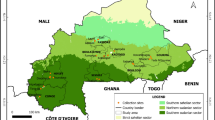Summary
Forty-eight accessions of tall fescue (Festuca arundinacea Schreb.), collected from Northern to Southern Italy, were analyzed using both univariate and multivariate analysis applied to a set of 12 quantitative traits. Four principal components were found to explain 77% of the total variation in the dependence structure. Productivity characters together with heading time and dimensions of flag leaf appeared to be the major sources of diversity among tall fescue populations. On the basis of the 4 principal components similar populations were clustered according to minimal distance analysis. Seven clusters were identified. The results of cluster analysis confirmed the presence of a remarkable diversity within the germplasm collection and explained why results of a univariate analysis of variance did not reveal significant differences among groups of accessions collected in Northern, Central and Southern Italy. The multivariate approach seemed to point out a problem of genetic erosion of the local germplasm in the Po Valley (Northern Italy) and, on the whole, appeared to be a valid system for tall fescue germplasm evaluation.
Similar content being viewed by others
References
Akoroda M.O., 1983. Principal component analysis and metroglyph of variation among nigerian yellow yams. Euphytica 32: 565–573.
Buckner R.C., B.P.Jerrell & R.V.Frakes, 1979. Historical development. In: Buckner R.C. and L.P.Bush (Eds.), Tall Fescue. Agronomy no 20, ASA, Madison, Wisconsin, USA: 1–8.
Burton G.W. & E.H.DeVane, 1953. Clonal evaluation in Tall fescue (Festuca arundinacea Schreb.) from replicated clonal material. Agron J 45: 478–481.
Busey P., T.K.Broschat & B.J.Center, 1982. Classification of St. Augustingrass. Crop Sci 22: 469–473.
Camussi A., 1979. Numerical taxonomy of italian populations of maize based on quantitative traits. Maydica XXIV: 161–174.
Goodman Major M., 1968. The races of maize: II. Use of multivariate analysis of variance to measure morphological similarity. Crop Sci 8: 693–698.
Griffith, D.J., J. Lewis & E.W., 1966. The problem of breeding for improved seed yield in grasses. Proc. of the X Int. Grassl. Cong. 7–16 July 1966, Helsinki: 749–754.
Hartley, W. & G.L. Williams, 1956. Center of distribution of cultivated pasture grasses. Proc. 7th Intnl. Grassld. Congr., New Zealand: 190–199.
Hawkes, J.G., 1980. Crop genetic resources field collection manual. IBPGR and Eucarpia: pp. 37.
Hill, M.J. & A.C. Kirby, 1985. Morphological variation in prairie grass. Proc. 15th Intnl. Grassl. Congr., Japan, Voluntary Session 1 (interim issue): 1-P-10.
Lorenzetti F., 1978. Il contributo del miglioramento genetico alla valorizzazione dei terreni marginali. Genet Agr 32: 109–124.
Lorenzetti F. & M.Falcinelli, 1976. Valutazione di specie e varietà e direttive per il miglioramento genetico delle graminacee foraggere per i pascoli asciutti dell'Italia centrale. Riv di Agron 10: 94–101.
Ohta, K. & M. Ochi, 1985. Fall panicum (Panicum dichotomiflorum Michx.) in Japan. Proc. 15th Intnl. Grassl. Congr., Japan, Voluntary Session 1 (interim issue): 1-0-7.
Ottaviano E., T.Schiva & M.Sari Gorla, 1974. Analisi multivariata per 1o studio delle differenze genetiche in popolazioni di Gerbera jamesonii. Genet Agr 28: 292–306.
Porceddu E., 1976. Variation for agronomical traits in a world collection of durum wheat. Z. Pflanzenzüchtg 77: 314–329.
Rao G.V.S. & R.S.Paroda, 1982. Factor analysis in cluster-bean (Cyonomopsis tetragonoloba (L.) Taub.). Theor Appl Genet 62: 273–276.
Schaaf H.M., 1968. Phenotypic selection in Crested Wheatgrass. Crop Sci 8: 642–647.
Seiler G.J. & R.E.Stafford, 1985. Factor analysis of components of yield in guar. Crop Sci 25: 905–908.
Sneath P.H.A. & R.R.Sokal, 1973. Numerical Taxonomy. W.H. Freeman and Company, San Francisco: pp. 573.
Sokal R.R. & F.J.Rohlf, 1981. Biometry, 2nd Ed. W.H. Freeman and Company, San Francisco: pp. 859.
Spagnoletti Zeuli P.L., C.DePace & E.Porceddu, 1984. Variation in durum wheat populations from three geographical origins. I. Material and spike characteristics. Euphytica 33: 563–575.
Talamucci P., 1981. Graminacee da prato. In: Baldoni R. and L.Giardini (Eds.), Coltivazioni erbacee. Patron, Bologna, Italy: 915–953.
Talamucci P. & G.Pazzi, 1980. Prime esperienze sulla raccolta in successione di graminacee foraggere nelle aree marginali del Mugello (FI) e dell'alta Val di Taro (PR). Proc. La problematica delle Terre Marginali, Consiglio Nazionale delle Ricerche, Roma, June 26, 1978, Vol. I: 53–61.
Terrell E.E., 1979. Taxonomy, morphology, and phylogeny. In: Buckner R.C. and L.P.Bush (Eds.), Tall Fescue. Agronomy no 20, ASA, Madison, Wisconsin, USA: 31–39.
Walton P.D., 1972. Factor analysis of yield in spring wheat (Triticum aestivum L.). Crop Sci 12: 731–733.
Author information
Authors and Affiliations
Additional information
Research supported by C.N.R., Italy, special grant I.P.R.A., Subject 1.5.1., paper n. 1146.
Rights and permissions
About this article
Cite this article
Veronesi, F., Falcinelli, M. Evaluation of an Italian germplasm collection of Festuca arundinacea Schreb. through a multivariate analysis. Euphytica 38, 211–220 (1988). https://doi.org/10.1007/BF00023523
Received:
Accepted:
Issue Date:
DOI: https://doi.org/10.1007/BF00023523




